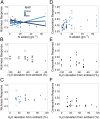Global change effects on plant communities are magnified by time and the number of global change factors imposed
- PMID: 31427510
- PMCID: PMC6731679
- DOI: 10.1073/pnas.1819027116
Global change effects on plant communities are magnified by time and the number of global change factors imposed
Abstract
Global change drivers (GCDs) are expected to alter community structure and consequently, the services that ecosystems provide. Yet, few experimental investigations have examined effects of GCDs on plant community structure across multiple ecosystem types, and those that do exist present conflicting patterns. In an unprecedented global synthesis of over 100 experiments that manipulated factors linked to GCDs, we show that herbaceous plant community responses depend on experimental manipulation length and number of factors manipulated. We found that plant communities are fairly resistant to experimentally manipulated GCDs in the short term (<10 y). In contrast, long-term (≥10 y) experiments show increasing community divergence of treatments from control conditions. Surprisingly, these community responses occurred with similar frequency across the GCD types manipulated in our database. However, community responses were more common when 3 or more GCDs were simultaneously manipulated, suggesting the emergence of additive or synergistic effects of multiple drivers, particularly over long time periods. In half of the cases, GCD manipulations caused a difference in community composition without a corresponding species richness difference, indicating that species reordering or replacement is an important mechanism of community responses to GCDs and should be given greater consideration when examining consequences of GCDs for the biodiversity-ecosystem function relationship. Human activities are currently driving unparalleled global changes worldwide. Our analyses provide the most comprehensive evidence to date that these human activities may have widespread impacts on plant community composition globally, which will increase in frequency over time and be greater in areas where communities face multiple GCDs simultaneously.
Keywords: community composition; global change experiments; herbaceous plants; species richness.
Conflict of interest statement
The authors declare no conflict of interest.
Figures



References
-
- Cardinale B. J., et al. , The functional role of producer diversity in ecosystems. Am. J. Bot. 98, 572–592 (2011). - PubMed
-
- Smith M. D., Knapp A. K., Collins S. L., A framework for assessing ecosystem dynamics in response to chronic resource alterations induced by global change. Ecology 90, 3279–3289 (2009). - PubMed
-
- Chalcraft D. R., et al. , Scale-dependent responses of plant biodiversity to nitrogen enrichment. Ecology 89, 2165–2171 (2008). - PubMed
-
- Dornelas M., et al. , Assemblage time series reveal biodiversity change but not systematic loss. Science 344, 296–299 (2014). - PubMed
Publication types
MeSH terms
LinkOut - more resources
Full Text Sources

